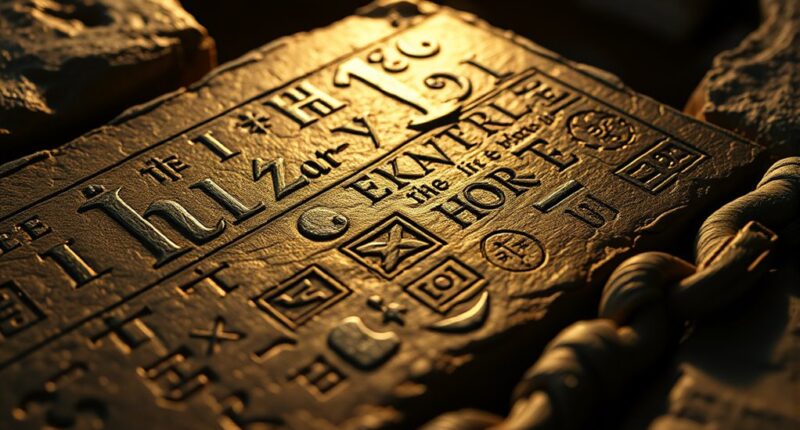The Genesis Block’s message, including the famous headline from The Times, was deliberately embedded to show how cryptography creates a tamper-proof foundation for Bitcoin. It symbolizes the start of a secure, decentralized system that relies on cryptographic hashes to guarantee transparency and resistance to changes. This design choice demonstrates how blockchain’s core security features build trust without traditional institutions. Continue exploring to uncover how these cryptographic techniques truly revolutionize digital currency.
Key Takeaways
- The embedded message in the Genesis Block references a 2009 newspaper headline, marking a cryptographic timestamp.
- It demonstrates how blockchain uses cryptography to create tamper-proof, trustless records from the very first block.
- The Genesis Block’s design showcases cryptographic linking that ensures the integrity and security of the entire blockchain.
- Decoding reveals the deliberate inclusion of a message to establish a cryptographically resistant historical record.
- This foundational block signifies the start of a secure, transparent, decentralized digital currency system.

Have you ever wondered about the origin of Bitcoin? It all begins with the Genesis Block, the very first block in the blockchain, which set the foundation for a revolutionary form of digital currency. To truly grasp its significance, you need to understand some blockchain fundamentals. At its core, a blockchain is a decentralized ledger that records transactions across multiple computers, making it transparent and tamper-proof. This technology relies heavily on cryptographic techniques to secure data, ensure integrity, and enable trust without a central authority. The Genesis Block isn’t just a starting point; it’s a symbol of how these cryptographic methods can create a secure, immutable record from scratch.
The Genesis Block marks the start of blockchain’s secure, tamper-proof digital currency revolution through cryptography.
When Satoshi Nakamoto mined the Genesis Block in 2009, they embedded a unique message in its code — “The Times 03/Jan/2009 Chancellor on brink of second bailout for banks.” This message wasn’t just a timestamp; it was a deliberate cryptographic choice, showcasing how blockchain technology can incorporate data that’s both time-stamped and resistant to alteration. The use of cryptographic techniques here is essential because it ensures that each block, including the Genesis Block, is connected through secure hashes. These hashes act like digital fingerprints: any change in the block’s data results in a different hash, making tampering obvious. This cryptographic linking of blocks forms the backbone of blockchain security, preventing anyone from modifying past records without detection.
Decoding the Genesis Block reveals more than just technical intrigue. It highlights how the blockchain’s design hinges on cryptography to create trustless systems—where you don’t need a middleman or a third-party authority. Instead, the integrity and transparency come from the cryptographic techniques embedded in each block. By understanding this, you see that the Genesis Block isn’t just a starting point but a proof of concept: that secure, decentralized digital cash could exist without traditional financial institutions. It’s this clever use of cryptography and blockchain fundamentals that allowed Bitcoin to pioneer a new era in digital finance.
In essence, decoding the Genesis Block shows how foundational cryptographic techniques are to the entire blockchain ecosystem. From hashing to digital signatures, these methods keep the system secure and trustworthy. You now understand that the first block’s significance goes beyond its content; it’s a demonstration of how cryptography and blockchain fundamentals can work together to build a resilient, transparent, and decentralized financial network. The mystery of the Genesis Block is finally unraveled, revealing the clever design choices that launched a global movement. Understanding the importance of cryptography in blockchain is key to appreciating how this technology maintains security and trust without a centralized authority.
Frequently Asked Questions
Who Created the Genesis Block Originally?
You might wonder who created the genesis block, the first step in block creation with cryptographic origins. It was mined by Satoshi Nakamoto, the mysterious creator of Bitcoin, who designed this initial block to establish the blockchain’s foundation. By doing so, they set the cryptographic standards that secure the entire network, marking the beginning of digital currency. Their work remains a pivotal moment in blockchain history, shaping decentralized finance as we understand it.
Are There Hidden Messages Within the Genesis Block?
You wonder if there are hidden messages within the genesis block. While some believe it contains cryptographic clues, no concrete evidence confirms secret messages. Developers designed it to establish the blockchain, not to hide information. However, enthusiasts analyze its code and data for any cryptographic clues that might reveal secret messages. Currently, the consensus is that the genesis block’s primary purpose is technical, not clandestine, but curiosity keeps the search ongoing.
How Does the Genesis Block Influence Current Blockchain Technology?
You understand that the genesis block shapes blockchain origins by setting the foundational code and structure. Its cryptographic significance guarantees security and trust, acting as the starting point for all subsequent blocks. By establishing the first reference point, it influences how new transactions are validated and added. Without this initial block, the integrity of the entire blockchain would be compromised, highlighting its critical role in maintaining a secure, decentralized ledger.
Was the Genesis Block Part of a Larger Cryptographic Puzzle?
You might wonder if the genesis block was part of a larger cryptographic puzzle. While some believe it contains hidden messages or clues, most experts see it as a foundational element rather than a secret code. The cryptographic puzzles you hear about today are more complex, designed to secure the network. The genesis block primarily establishes the blockchain, not a hidden message, but it’s intriguing to contemplate its potential secrets.
Could the Genesis Block Reveal Future Blockchain Developments?
You might wonder if the genesis block reveals future blockchain developments. It does, in a way, by illustrating cryptocurrency origins and blockchain symbolism. As the first block, it sets the tone for transparency, security, and decentralization, guiding future innovations. Analyzing its structure and embedded messages can inspire new features or protocols, helping you better understand how blockchain evolves and how its foundational principles shape upcoming advancements.
Conclusion
Now that you’ve uncovered the secrets behind the Genesis Block, you see how it laid the foundation for blockchain technology. Its unique origins set the stage for a decentralized revolution, proving that innovation often starts with a single, mysterious block. You’re now equipped with the knowledge to appreciate the significance of this historic milestone, and you can confidently follow the ongoing evolution of crypto. The mystery’s finally decoded—your journey into blockchain just got even more exciting.









